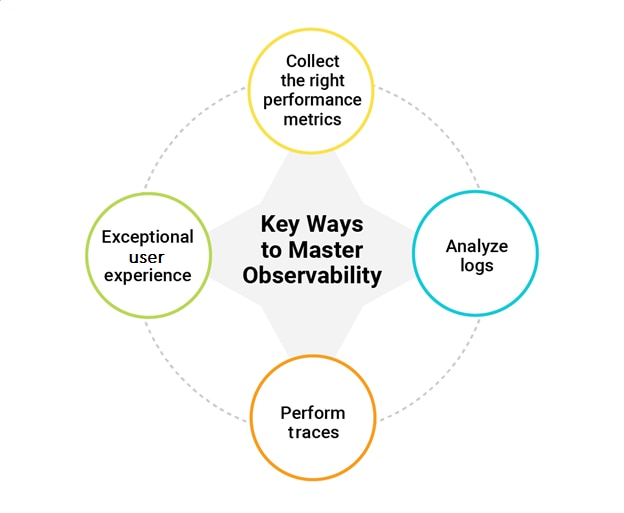Using the cloud can be challenging. Everyone likes to tell stories about a surprise cloud bill they received and laugh, but let’s be honest: it’s happened to all of us.
When dealing with complex cloud environments and cloud-native architectures, gaining visibility into the state of the environment is critical. Today, developers are looking to monitor how things are working and performing as part of every step in the software development life cycle. This is a far cry from the way developers operated years ago, when they only really looked at things once they considered code to be complete.
No matter whether you’re looking at things from a developer or an operational perspective, observability in the cloud is a different game altogether. For example, traditional infrastructure teams may be used to looking at only their side of things, such as virtualization or storage. In the cloud, teams are looking at everything and working together from the get-go.
One thing capable of helping to eliminate—or at least reduce—the issue of effectively monitoring across all the microservices, applications, and components being spun up instantly in cloud environments is a special flavor of something you may already have heard about: observability. However, managing cloud-native technologies is a common challenge I’ve seen many organizations struggle with, one where o11y, or observability, plays a huge role.
Let’s take a closer look at how o11y can differ for cloud environments and what it takes to master cloud-native observability.
But first, what does "o11y" mean?
As you research observability, you might see the term also referred to as o11y, pronounced “ollie.” The “o” stands for observability, and there are 11 letters between “o” and “y,” which is the genesis of “o11y.” Condensing longer terms like this is a common practice called a numeronym. Other examples include “i18n” for internationalization, “a11y” for accessibility, and maybe we can get “o11y” trending for
OpenTelemetry (oops, I guess OTEL will have to do).
What is observability for cloud-native technologies?
At the highest level, observability is the ability to provide insights, automated analytics, and actionable intelligence through the application of cross-domain data correlation, machine learning (ML), and AIOps across massive real-time and historical metrics, logs, and trace data. This provides unprecedented views into our systems.
For those who operate solely in the cloud or are adopting the cloud moving forward, there are some unique observability needs. When we talk about things being cloud native, it’s important to maintain the levels of observability we’re used to having to support our business requirements. As we move to a cloud-native model, users expect faster deployments and issue resolution as well as better outcomes all around.
Why organizations struggle with cloud-native observability
Organizations often struggle with cloud-native observability because they don’t have the proper instrumentation or knowledge in place to make the most out of the data and understand how their cloud-native technologies and open-source frameworks are operating.
Cloud adoption has accelerated in recent years, thanks to
methodologies like DevOps and technologies like
Kubernetes. The wonderful thing about the cloud is new environments can be deployed rapidly, making it an endless resource pool for application development.
It isn’t without its drawbacks, though. Though clouds are easy to consume, they can also be complicated because they consist of so many different services needing to work together. When it comes to the cloud and its virtually unlimited resources, this complexity can work against it. For instance, application performance issues are often due to simple misconfigurations of a service. This is why it’s important for organizations to have a view into all the services they’re consuming inside and outside the cloud and how they work together.
When it comes to the pace of cloud adoption and deploying containers and
microservices, traditional monitoring tools can fall short in helping organizations make the best business decisions possible. This is where a cloud-native, modern observability solution comes into play.
Mastering o11y for cloud-native technologies
Having an effective o11y strategy specifically for cloud-native technologies should include some key features to help provide the visibility you need into the sheer volume of data generated in these environments. Let’s look at these features and why they matter when ensuring availability and performance for cloud-native custom applications and microservices.

Collecting the right performance metrics
Though we’re used to the world of performance metrics and alerting from traditional monitoring systems, an observability platform designed for cloud-native technologies needs to go a step further. By ingesting the right data, an o11y solution can provide insights into something not working correctly and can even predict problems before they manifest by viewing system performance values alongside important data like service-level indicators, latency, and downtime. These views can provide actionable information to organizations to help them stay ahead of issues.
Gathering and analyzing logs
Log analysis is a key part of observability platforms since logs contain so much data about how a system is functioning. Logs provide time-stamped, step-by-step records of every event in an environment. You can then correlate them to performance data and more, offering a complete picture of how an environment is performing. This is especially important when it comes to distributed systems, which many cloud-native applications are by nature.
Performing traces
Another key component of an o11y solution is the ability to collect traces. In complex systems like cloud-native applications, it’s crucial to be able to see the end-to-end picture to understand what’s truly going on. This can be a complicated and time-consuming (not to mention frustrating) manual process. The right observability tools can do this quickly while correlating traces with the other metrics being observed in the environment.
Providing an exceptional user experience
Since teams across an organization can use o11y solutions, they need to provide an exceptional end-user experience across different needs and use cases. They should be simple to use and deploy and allow teams to see various metrics in one place. From visualization dashboards to the ability to see what issues are occurring in the environment, the right solution will make life easier, not more difficult.
This is especially important since many organizations operate in a hybrid cloud model. Look for an observability solution designed to provide insights across the technology stack for insight into cloud-native and on-premises applications .
Solving o11y challenges for cloud-native technologies
If you’re looking for an observability solution to support cloud-native technologies,
SolarWinds Observability SaaS (formerly known as SolarWinds Observability) is built to deliver unified and comprehensive visibility for cloud-native custom web applications. SolarWinds Observability SaaS (formerly known as SolarWinds Observability) helps ensure optimal service levels and user satisfaction with key business services to keep your systems operating a peak efficiency.
You can learn more about the current challenges organizations with cloud-native technologies face and how application performance management (APM) and observability solutions help businesses drive better outcomes in this
GigaOm report.








